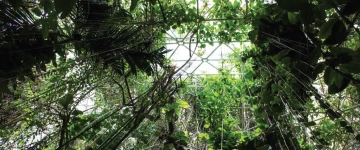
The rainforest at Biosphere 2
University of Arizona
In an unprecedented experiment, University of Arizona scientists subjected the 30-acre, enclosed rainforest at Biosphere 2 to a three-month drought before reintroducing healthy moisture levels. The resulting data is revealing how plants and soil-based microbes responded – knowledge that could prove critical for adapting to a hotter, drier world.
The newest branch of research, led by associate professor Malak Tfaily in the College of Agriculture, Life and Environmental Sciences, reveals what happens
underground during and following drought. Throughout the experiment, sensors documented changes in the forest’s rhizosphere – the zone surrounding roots, where complex interactions with soil microbes occur.
Data showed notable drops in the levels of organic compounds that plants pumped out from their roots. Microbes in soil depend on these root exudations for energy. Reducing them can change the composition and activity of microbial communities, altering how they cycle nutrients.
Research also showed that the effects of drought on soil microbes varied with the plant species associated with those microbial communities. The finding suggests that depending on the composition of the ecosystem, drought-tolerance strategies can incorporate different interventions to produce different targeted effects below ground.
Finally, soil microbes in drought conditions released more volatile organic compounds (VOCs) and released them later in the day. Researchers theorize this microbial response might increase the potential for cloud cover in real world conditions. Ambient air is hotter later in the day and therefore more likely to carry VOCs high enough to seed cloud formation.
